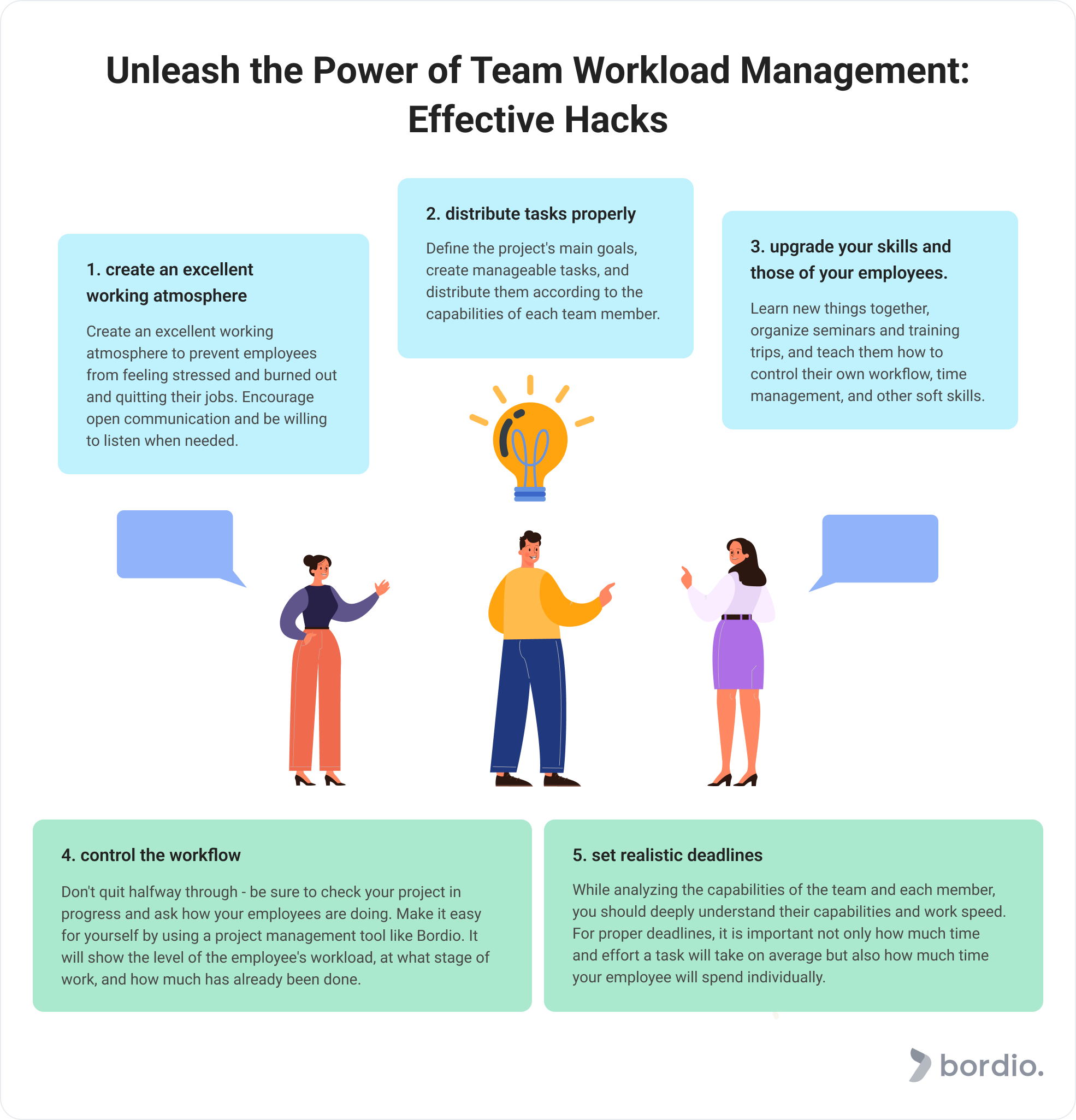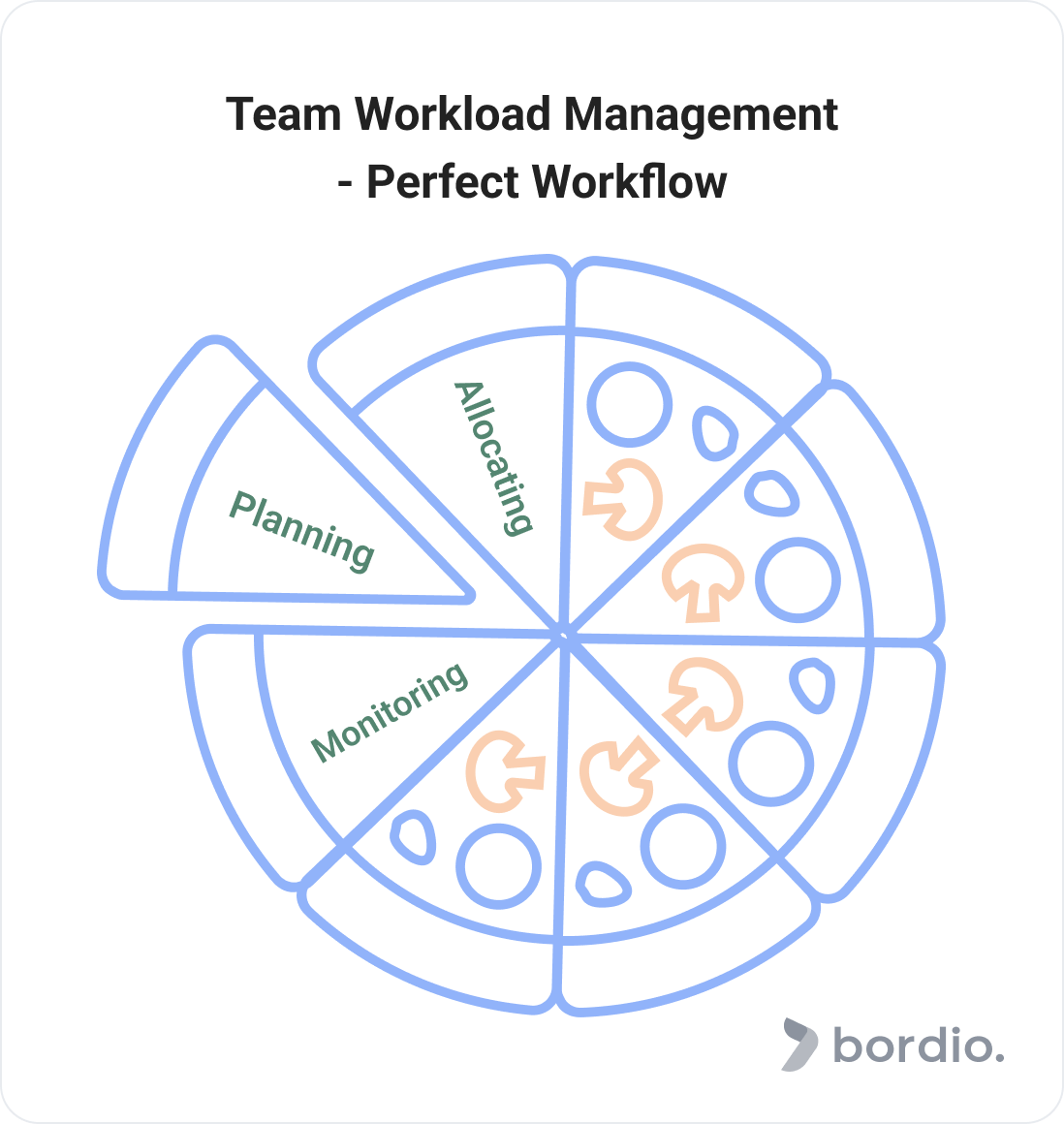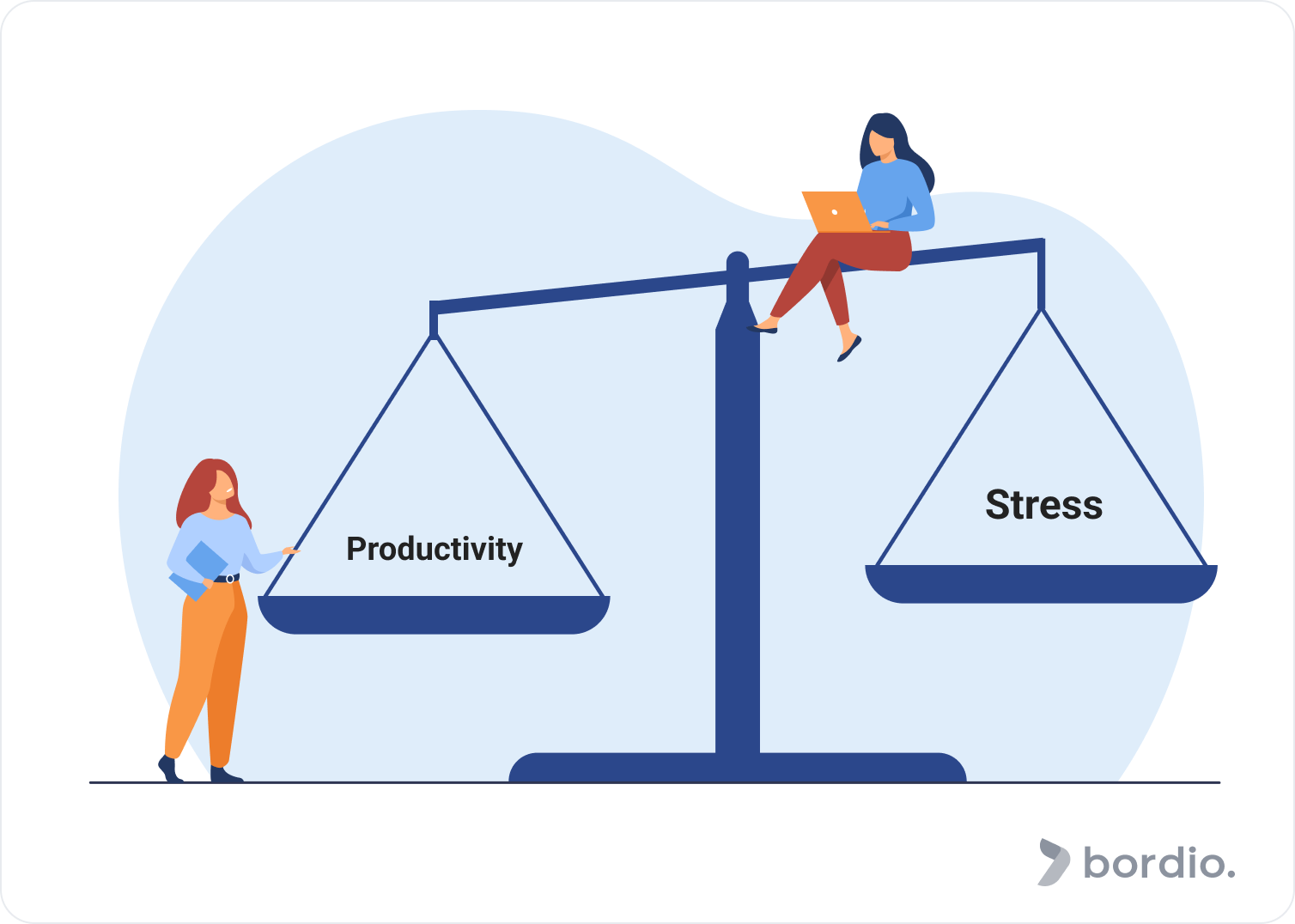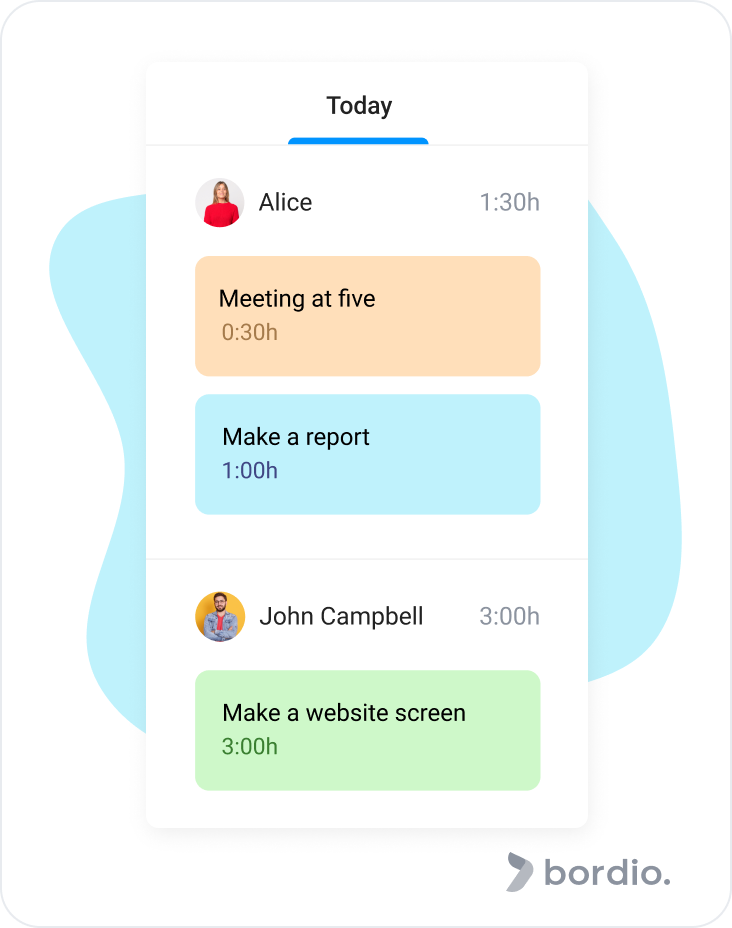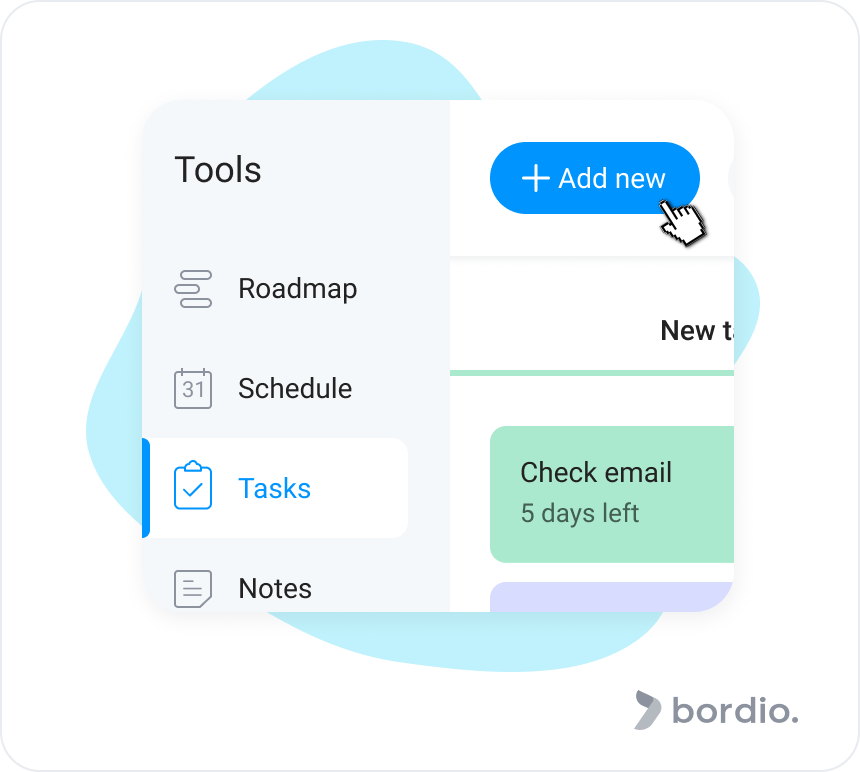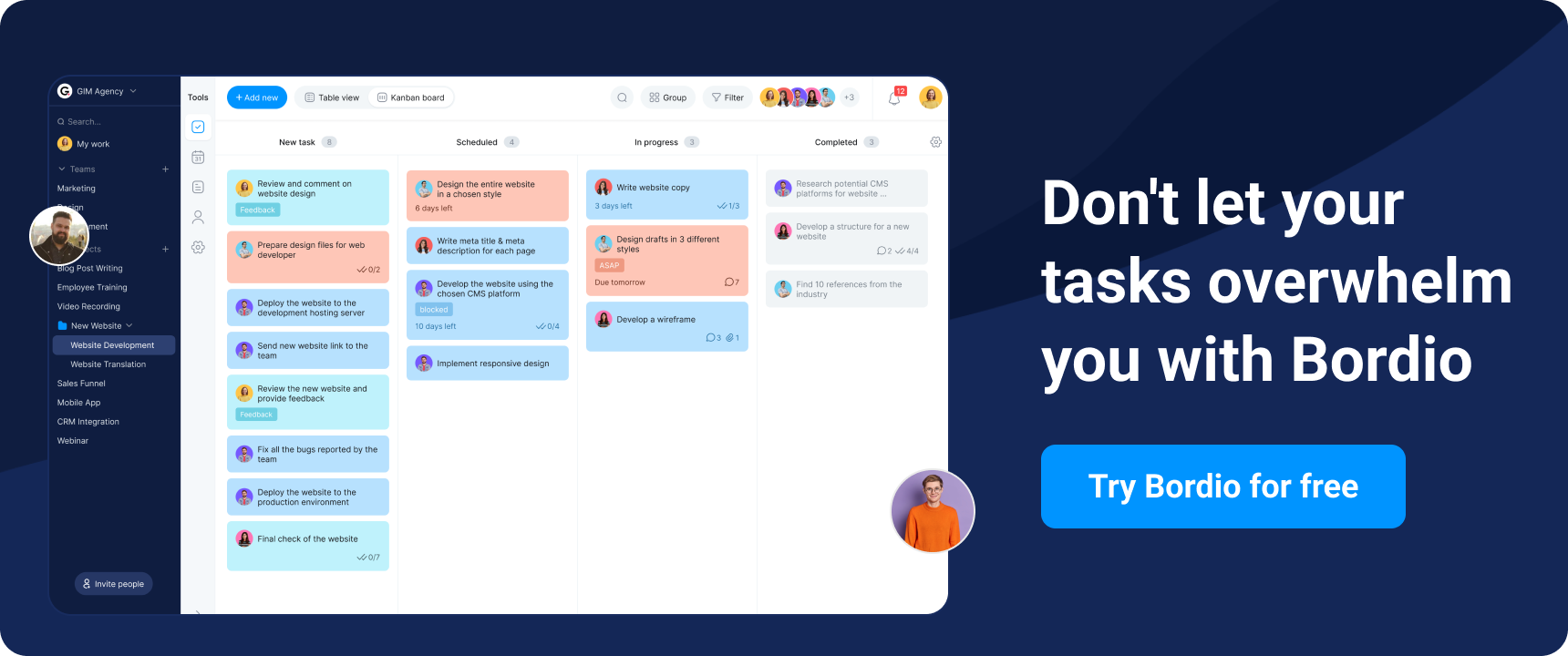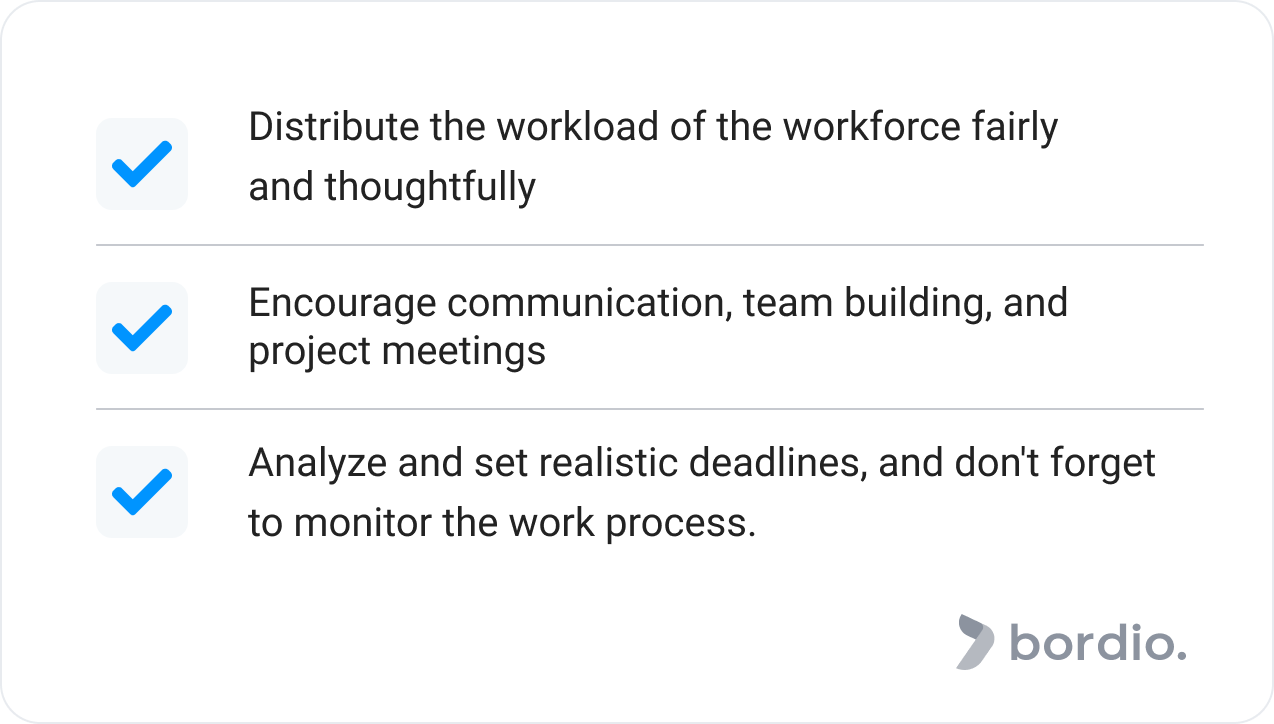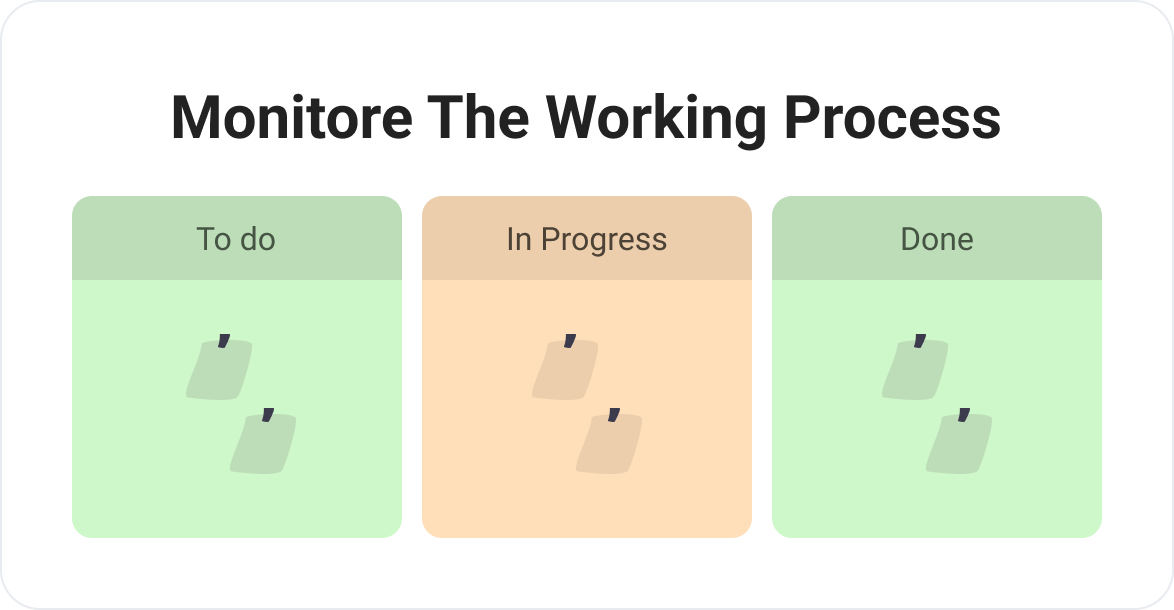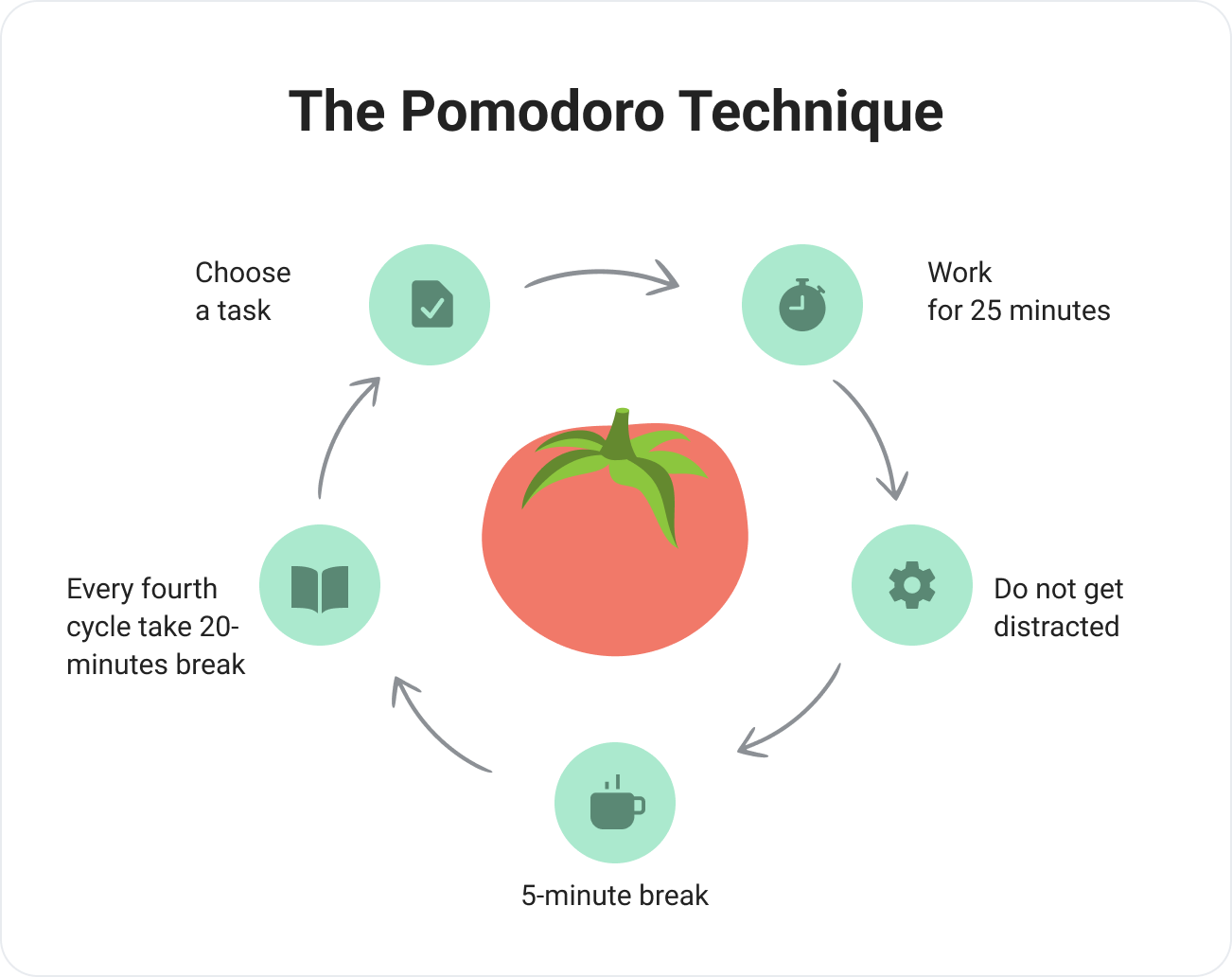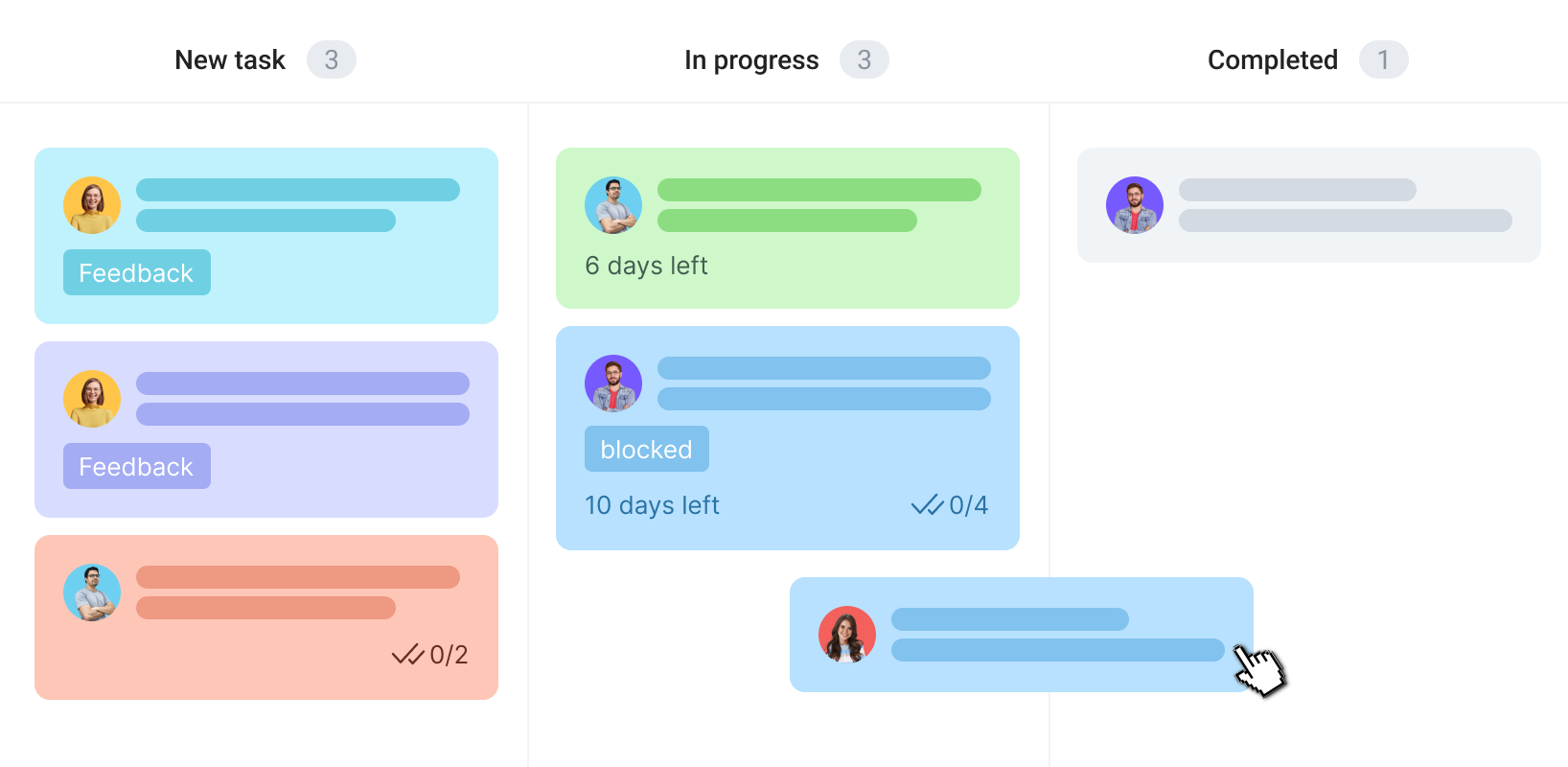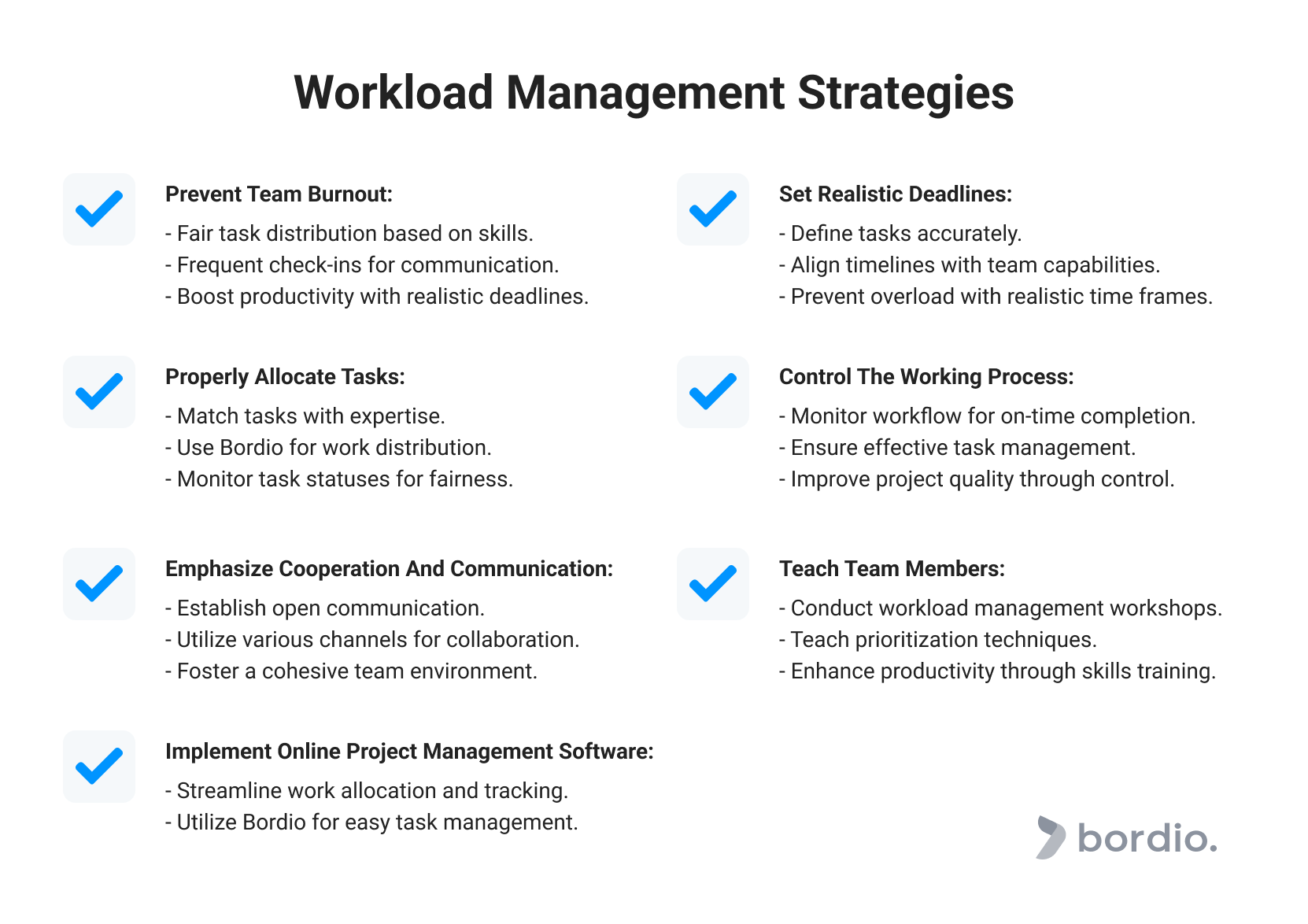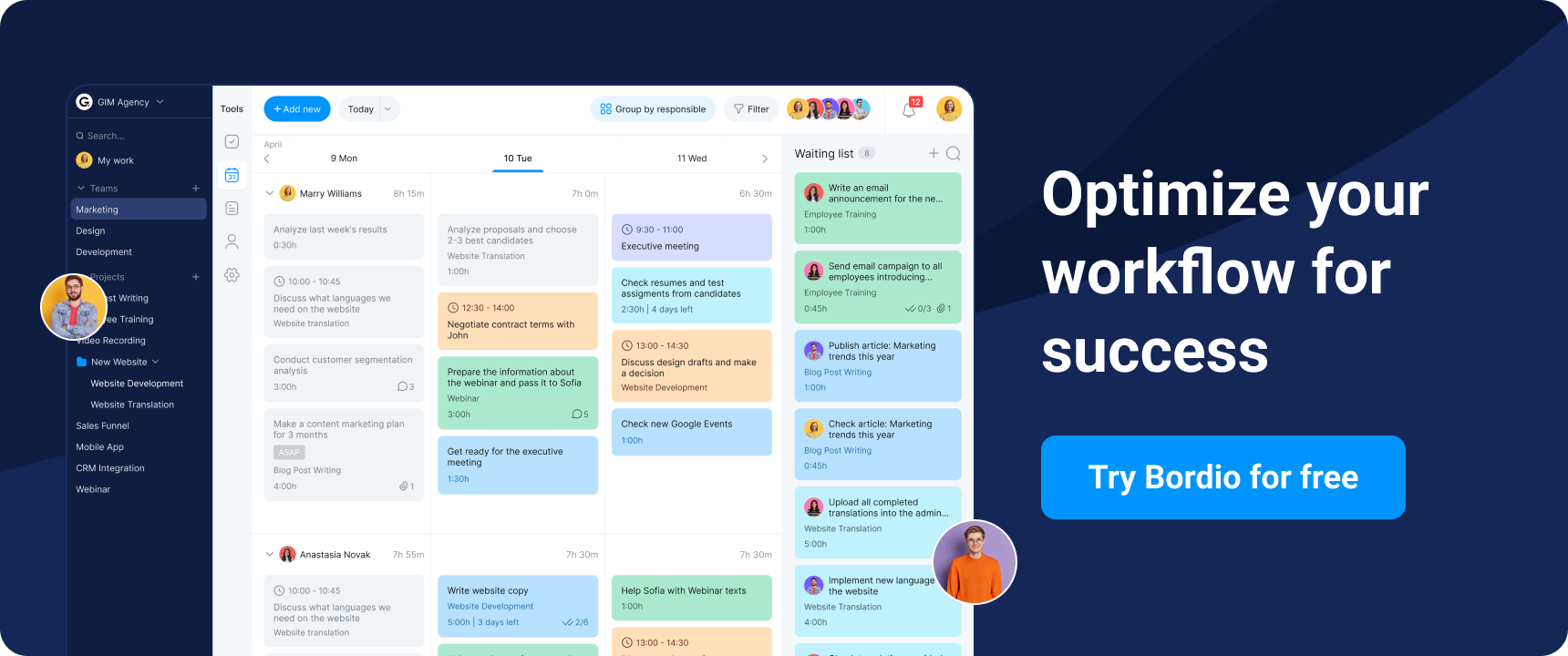Picture this: your team managing a top-notch marketing agency that produces commercials for complex projects, designs websites, develops marketing strategies, and works on four demanding project tasks. Seems like too much, right? It’s challenging to manage a team with many responsibilities, and how can you make it easier for you? So, in this article, we are going to find a solution.
Team workload management is like the main ingredient in a dish – the perfect workflow
Workload management is like the cheese in a pizza – central to a team’s recipe for success. As a project manager, you are a chef distributing tasks like ingredients, ensuring your team gets the right amount of work without overworking or feeling bored. The workload management process involves task planning, scheduling in workload management tools, and monitoring workloads to ensure that teams achieve their goals and that work is distributed evenly among team members. As projects progress, you monitor everyone’s workload to ensure it’s balanced and monitor the distribution of tasks to maximize individual and team performance.
So why is this important? When your team is drowning in tasks, productivity drops, and burnout becomes an uninvited guest at the table. What is burnout? It is often the main course that makes employees decide to quit.
Effective workload management isn’t just about boosting morale; it’s also about saving money. Imagine the kitchen analogy again: there are fewer cooks, but orders are filled faster than a well-oiled machine. You grow your business without robbing a bank. So, managing the workload is not just about being the boss; it’s about being the backbone of a well-functioning team. Do it right, and you’ll see your team thrive.
Impact of team workload management on the team’s health?
Workload management is a way to keep a team engaged and productive – the strategic skill of distributing work among team members to increase productivity. However, managing workload reduces stress, burnout, and errors in team performance. Nowadays, when everyone thinks a lot about how to become successful and productive quickly and never struggle with procrastination, we forget about mental health. Of course, workload management helps organizations implement projects successfully, and it is also helpful for team capacity planning, resource utilization, improving the entire team’s efficiency, and other positive effects on business. Still, the key for those who are concerned about business and the well-being of employees in it is stress reduction.
When you do an excellent job of managing workloads, your team comes to make positive improvements:
- Firstly, properly allocating responsibilities, assigning tasks, and open communication will reduce stress, increasing the team’s performance.
- Secondly, team members who are not overwhelmed with multiple projects will not feel overwhelmed and overworked and will not burn out – which is essential.
- Finally, the consequence of a balanced team workload is that in your team will be no overloaded team members, preventing resentment and dismissals and attracting new qualified employees.
Bordio’s worth in helping manage team workload
And so, realizing how important it is to be a project manager who can balance the team’s workload, we have reached a point where we want to know how it can be done. Luckily, like every chef, we have our secret ingredient – and it’s Bordio! Bordio is a project management software that helps you cope with high workloads, task management, and other complexities of team life.
So what is Bordio’s help? First of all, it is easy task allocation and time management. In this software, you can monitor the team’s work progress, and how busy the participants are and create new tasks. Bordio is a great online scheduler that is supplanting its paper counterparts. Only in an online scheduler can you drag and drop tasks, regardless of the project stage, and create events without notifying your employees about them – the program will do it for you.
Another important feature is the ability to see the amount of time spent on individual tasks and the total working time of each employee. Bordio will automatically calculate tasks and events so that you can accurately determine the level of employees’ workload.
You probably know how important it is to be flexible in your projects to change tasks and goals during the process – and Bordio will give you this opportunity! Besides, Bordio has all the features of a handy calendar, so you don’t have to download other programs – it’s all in one place. Isn’t it convenient enough?
Team’s Workload Management Challenges
1. Team burnout
A team environment might be depressing if the team’s tasks are not distributed relatively without proper workload management. Some team members may experience overload when they have a lot on their plate – like someone attempting to balance too many dishes simultaneously. Those who have a lesser task, however, might feel unappreciated. This mismatch in the workload may ruin the team’s chemistry. Result? The entire team is feeling overwhelmed. That’s why fair workload management and prioritizing tasks are essential for team job satisfaction and being high performers.
2. Missed deadlines
An unbalanced workload increases the likelihood of missing project deadlines – and you know what happens when you overdo a cake in the oven – it burns. Overworked team members may not be able to complete their tasks on time. Ineffective workload management decreases the organization’s reputation and disrupts the project’s carefully planned schedule. Lack of team feedback and team leaders forgetting to check in regularly during the project make it impossible to manage deadlines.
3. Quality problems
Following from the previous point – rushing through tasks and overload due to adjacent deadlines leads to problems with quality and errors. In addition, with poor distribution, tasks may become unimportant to someone, and other tasks that seem impracticable will significantly impact the project. Rushing through tasks due to an uneven workload is like trying to cook a dish in the microwave and ending up with a fast-food project. Other team members may also feel the stress of taking sick leave or quitting altogether, which is unsuitable for us and the entire project.
Making proper team workload planning: 3 Hacks
It may seem that achieving the ideal is difficult, but let’s decide on the key simple steps you will need to follow during project planning so that managing a team workload will seem like a cake to eat.
Transparent Task Allocation:
To successfully manage a team’s workload, you must adequately assign tasks, and for that, you must conduct a detailed analysis, identify each participant’s areas of expertise, and understand which tasks best match their skills. This personalized approach increases task efficiency and motivates the team by engaging in a cause they truly care about. That’s an essential component of effective workload management that minimizes the possibility of miscommunication and limitations while precisely defining activities.
An environment of trust and collaboration is created when each member is aware of their position and recognizes how they contribute to the whole project’s success. Hence, explicit problem-solving for project managers is a tactical approach to maximizing collaboration and having workload management software for recognizing each team member’s special skills and aptitudes and a means of establishing the framework necessary to accomplish project objectives.
Regular Check-ins:
Reviewing processes not only makes it easier for information to be shared openly, but they also provide a chance for quick corrections. Like keeping an eye on the cooking process, routine check-ins enable fast identification and resolution of any possible issues or inconsistencies.
Regular check-ins also facilitate open communication among team members, allowing them to share any thoughts, worries, or recommendations. This is necessary for a team to work cohesively, where flexibility and openness are critical to success. Thus, regular check-ins are essential to effectively manage a team’s workload because they guarantee continued control, comprehension, and preparedness to adapt to changes in the workplace. It will be easier to control a project’s progress if you implement an excellent workload management tool in your working process.
Set Realistic Deadlines:
Setting reasonable deadlines requires careful assessment of the current work environment, just as an experienced chef knows how long to cook each dish component. This is important because, along with assessing the abilities of team members, you also need to assess how complex the tasks are and how much time they will require.
By setting appropriate deadlines, you can save your team members from unnecessary stress, which can lead to burnout and emotional breakdown. This strategy also helps create a supportive team environment where employees believe they can accomplish the assigned tasks. This setup makes you more productive, reduces the likelihood of errors, and increases the likelihood of successful project completion.
What tips and tricks should you know for successful team workload management?
Using project management tools will help you monitor your team’s work effectively. It’s like using the proper kitchen utensils to prepare delicious meals. Tools make managing the team’s workload, monitoring progress, and collaborating as a team easier. By introducing these tools to your team, you can then motivate your team to create strategies and track progress. Teach them how to prioritize, delegate responsibilities, and increase productivity with tools like the Pomodoro technique.
Teamwork requires good cooperation and communication. This includes business emails, project notes in the planner, business correspondence, online meetings, and live project discussions. Create an environment where employees can communicate and collaborate freely. Utilize communication platforms to facilitate information sharing and make communication transparent.
Training and support skills are essential for the team. Conduct training and workshops to enhance the skills of the team. Support their desire to grow professionally by creating an environment where learning and development are the norm. And, of course, don’t forget to listen to people and their suggestions – they shouldn’t feel like they have no voice.
Teaching your team to make good workload management
It’s not enough to be a good project manager; each team member also has to be able to understand and conduct workload management strategy, use workload management tools, and be on the same page with you. So, how do we make it happen?
Begin by emphasizing the value of workload management. Inform your staff of how it affects each person’s well-being and general productivity. Organize workshops or training sessions on managing workload. Team members may better manage and prioritize their activities by exchanging tactics, resources, and best practices. Comment constructively on efforts made to manage workload. Praise accomplishments and offer guidance for areas in need of development.
Teach employees how to set priorities. Assist your team in identifying and concentrating on assignments following deadlines and organizational goals. Introduce time-management strategies, including time blocking, the Pomodoro Technique, and the Eisenhower Matrix. These techniques can help with time management and organization. Motivate group members to create SMART objectives. This aids in the development of a project and task roadmap.
Offer your team resources and access to technology that makes working with time tracking and workload management software easy. Calendars, workload management tools, task tracking tools, and project management software may be helpful. Emphasize the value of rest periods and breaks to your team, as it’s essential to have a healthy work-life balance. A well-rested team member can handle the workload and achieve high results.
Critical points of team workload management
As we finish our delicious meal, it’s time to wrap up. What steps must you take to avoid getting confused by workload planning and take advantage of different workload management strategies? We’ve put together a little checklist for you to make it easy to understand:
1. Prevent team burnout and stress
A transparent and fair job distribution is necessary to reduce team stress and burnout. This includes allocating responsibilities per each team member’s unique skills to manage the project’s workload. After planning, don’t forget to control the project further; frequent check-ins allow for open communication, facilitating quick problem identification and building a cooperative team atmosphere. Productivity may be increased by implementing useful techniques like realistic deadline setting, using the Bordio project management tool, and other workload management tools.
2. Set realistic deadlines
Project managers should start with a thorough understanding of the project’s scope. By clearly defining tasks and breaking the project into manageable tasks, the time required to complete each component can be more accurately estimated. Setting accurate due dates is essential to assess the team’s capacity. Understanding the skills, experience, and availability of team members helps align timelines with the actual capabilities of employees, prevent overload, and provide more realistic time frames.
3. Properly allocate tasks
A key component of effective team workload management is assigning responsibilities. Again, conduct thorough research on the team’s capacity to determine each member’s areas of expertise. Project managers can maximize efficiency and quality of work by assigning tasks that match each team member’s capabilities.
Task allocation is more accessible using a project management tool like Bordio. The program simplifies work distribution and time tracking, speeding up scheduling and tracking workload levels. You will be able to reassign tasks so planning becomes more flexible, and you can see task statuses to be aware of stages of plan completion. This increases productivity and offers a single platform for tracking individual and team workloads, ensuring that work is distributed fairly and team members are neither overloaded nor underloaded.
4. Control the working process
Maintaining control over the workflow is essential in managing workloads. Since the project’s outcome depends on it, process control is critical. Managers can ensure that tasks are completed on schedule, deadlines are met, and team members are utilized effectively if they actively monitor and manage the workflow. Ultimately, effective workflow management leads to improved product quality, increased productivity, and timely and successful project completion.
5. Don’t forget about cooperation and communication
Collaboration and communication between team members must be higher than in a standard business email. It is essential to establish settings that facilitate unrestricted communication and collaboration among team members using diverse channels, such as project notes and to-do’s, business mail, online meetings, and in-person project talks. The main objective is to establishing a cohesive team environment that encourages output and efficient project completion.
6. Teach team members
We recommend workload management workshops or trainings, creating a platform for team members to share tactics, resources, and best practices. This collaborative approach allows team members to manage better and prioritize their tasks, leading to increased efficiency and motivation.
Teach team members how to prioritize. Help them to identify and focus on tasks that align with the organization’s deadlines and goals. Implement time management strategies such as time blocking, the Pomodoro technique, and the Eisenhower matrix to help them master workload skills. These techniques promote better time organization and task prioritization, increasing individual and team productivity.
7. Implement online project management software
Putting online project management software into practice is crucial in efficiently managing team workloads. These technologies streamline project management by offering a consolidated work allocation, scheduling, and progress-tracking platform. Project managers may find a one-stop shop with Bordio, an application that provides features like simple work allocation, time tracking, and a calendar. This technology not only takes the role of conventional paper-based techniques but also enhances team cooperation and communication. Online work management software’s real-time capacity to track activities and workload makes it invaluable for preserving a balanced work distribution, accommodating shifting project objectives, and maximizing team performance.

